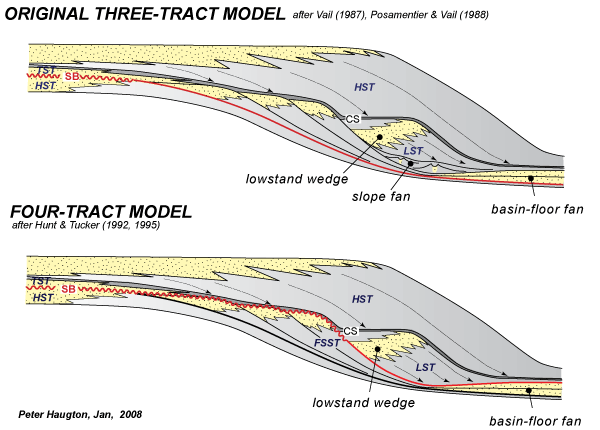|
boundaries
correlative conformity
highstand systems tract
sequence
unconformity

|
sequences are enveloped by sequence boundaries (SB) that are identified as significant erosional unconformities and their correlative conformities. These boundaries are the product of a fall in sea level that erodes the subaerially exposed sediment surface of the earlier sequence or sequences. These boundaries are diachronous, capping the previous highstand systems tract and eroding the surface of the downstepping sediments deposited during accompanying forced regression associated with the sea level fall (Catuneanu, 2002 ) (see movie).
Hunt and Tucker (1992) emphasize how the upper surface of downlapping and prograding shoreline of the forced regression is eroded and is expressed as a diachronous subaerial unconformity. Plint and Nummedal, (2000) name the subaerial unconformity that caps the forced regression as the "regressive surface of fluvial erosion". Hunt and Tucker (1992) match this unconformity to a downdip surface they call the marine correlative conformity and relate to the end of base level fall. The Hunt and Tucker (1992) suggest that this "sequence boundary" over the forced regression does not match Mitchum's (1977) original definition of a sequence boundary or its time equivalent marine correlative conformity that was tied to the onset of a sea level fall.

Note the correlative conformity on the top of the basin floor fan as suggested by Vail, 1987, versus the Hunt and Tucker, 1992 & 1995, models.
In the earlier literature two distinct types of sequence boundary were recognized. [ORIGINAL DEF]. These terms are now redundant because Type 1 sequence boundaries equate to those formed during a forced regression whereas Type 2 sequence boundaries are those forced during a normal regression (Coe et al. 2002). It has been demonstrated that the Type 1 and Type 2 unconformities can bound the same sequence at different localities and are the products of different rates of sedimentation and accommodation space (Posamentier and Allen, 1999) for the same time interval.

References
Catuneanu,O., 2002, sequence stratigraphy of clastic systems: concepts, merits, and pitfalls, Journal of African Earth Sciences, Volume 35, Issue 1, Pages 1-43
Catuneanu, Octavian, William E. Galloway, Christopher G. St. C. Kendall,
Andrew D. Miall, Henry W. Posamentier, André Strasser, and Maurice E. Tucker,
2011, "sequence stratigraphy:
Methodology and Nomenclature", Newsletters on stratigraphy, Stuttgart,
Vol. 44/3, 173–245
Coe, Angela, Dan Bosence, Kevin Church, Steve Flint, John Howell and Chris Wilson, (2002), The Sedimentary Record of Sea Level Change , Cambridge University Press, 288 pp.
Hunt, D., and M. E. Tucker, 1992, Stranded parasequences and the forced regressive wedge systems tract: deposition during base-level fall, Sedimentary Geology, 81, 1-9.
Hunt, D., and M. E. Tucker, 1995, Stranded parasequences and the forced regressive wedge systems tract: deposition during base-level fall-reply, Sedimentary Geology,95, 147-160.
Mitchum Jr., R.M., 1977, Seismic stratigraphy and global changes of sea level. Part 11: glossary of terms used in seismic stratigraphy. In: Payton, C.E. (Ed.), Seismic stratigraphy––Applications to Hydrocarbon Exploration, vol. 26. A.A.P.G. Memoir, pp. 205–212.
Plint, A.G., Nummedal, D., 2000, The falling stage systems tract: recognition and importance in sequence stratigraphic analysis. In: Hunt, D., Gawthorpe, R.L. (Eds.), Sedimentary Response to forced regression, vol. 172. Geol. Soc. London Speci. Publ, pp. 1–17.
Posamentier, H.W., Allen, G.P., 1999, Siliciclastic sequence stratigraphy: concepts and applications, SEPM Concepts in Sedimentology and Paleontology no. 7, 210 p
|